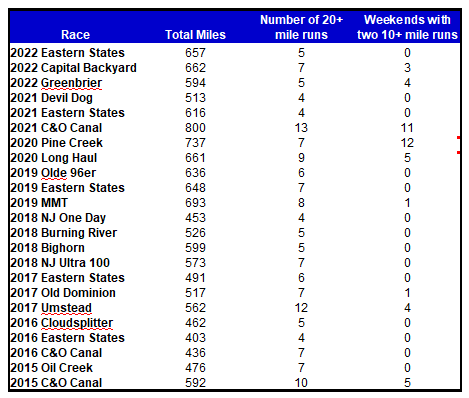For a number of years, I’ve tracked the amount of miles and long runs that I’ve done heading into my hundred milers. These aren’t training plans or even training blocks per se. More a general description of my running volume leading up to races.
First, let’s take a look at the 100 days before each of my 100 milers.
The biggest takeaway from the above table is that there is more than one way to skin a cat. And these numbers don’t really correlate to how well I did in each race. Just look at my first 2 back in 2015. Based on these numbers, you would have assumed that Oil Creek would have been my DNF and not C&O Canal. Training volume will get you to the starting line, but it’s not the only factor in how well you do. Apparently, you still need to actually run the race.
The biggest change over the years is that I’ve upped my mileage from the 400-500 mile range to 600-700. Not too long after I started running 100 mile races, I consciously cut back on my normal training mileage. I had built my body up to be able to handle the distances I was targeting and this was good enough for me. I wasn’t out to win anything so dropped my mileage to what I wanted to do. After a couple years, my weekly mileage started creeping up here and there. It was very organic. I never really came up with a plan. I’d just add a mile to my weekday run or do a couple extra miles on an off weekend. I’m still pretty much just a 5 day a week runner, but I’m going a little farther on each of the runs.
Now let’s zoom in a bit and just look at my Eastern States training volumes.

Let’s start with the obvious. Thirty miles a week for the 14 weeks leading into the 2016 race was clearly not enough. I had cut back my volume to try and heal up a weak knee. Sure, I managed to finish that race, but it was far from ideal. Looking back, my July elevation totals is what probably saved my race. I did lots of hill repeats that month.
I upped my mileage for 2017, but cut back on the hills for some reason. Big drop in July. This training block would be the poster child for not needing lots of elevation directly heading into the race. Or do as I say, not as I do.
After hanging out in the 1700-2000 miles per year range to start my running career, 2019 saw a spike in overall volume to 2461 miles. This translated to 600+ miles for the hundred days leading up to ES100. I also added lots of elevation gain to my higher volume for a very healthy total load. The last 2 years have kinda been about the same with increasing amounts of elevation in July. This is really the first time I’ve looked at July training volume, however it makes a lot of sense for Eastern States since it’s 2-6 weeks out or basically the highest volume period before my taper. Going forward, I’ll look to plan out my July running with a little more foresight. It wasn’t until the past week that I actually sat down and looked at my training leading up to the race. Luckily I have enough experience at this point that I don’t really need to ramp up for races. Just tune things up a bit here or there.
Only a couple more workouts until race day. And I’m already dreading Saturday’s. . .

